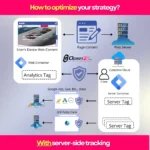Mastering SEO Search Optimization: Your Guide to Digital Visibility
SEO search optimization is the name of the game in today’s digital landscape. If you’re scratching your head wondering how to get your website noticed, you’re in the right place. Let’s dive into the world of SEO and uncover the secrets to boosting your online presence.
What’s the Big Deal with SEO Search Optimization?
Picture this: you’ve got a cracking website, but it’s buried on page 10 of Google. Sounds familiar? That’s where SEO search optimization comes in. It’s all about making your site irresistible to search engines so they’ll show it to more people. Simple, right?
But here’s the kicker – SEO isn’t just about pleasing robots. It’s about connecting real people with the information they’re after. And with Google handling a mind-boggling 5 trillion searches a year, there’s plenty of opportunity to get in on the action.
The SEO Landscape: Then and Now
Back in the day, SEO was a bit of a doddle. Find a keyword, stuff it in your content, build a few links, and boom – you’re on the first page. But those days are long gone, my friend.
Now, with AI churning out content faster than you can say “algorithm update,” the game has changed. Google’s gotten smarter, and so have we. It’s no longer about gaming the system – it’s about providing genuine value to your audience.
The Fundamentals of SEO Search Optimization
Before we get into the nitty-gritty, let’s cover the basics. These are the building blocks of solid SEO search optimization:
- Keyword Research: Understanding what your audience is searching for
- On-Page SEO: Optimizing your content and HTML source code
- Off-Page SEO: Building authority through backlinks and social signals
- Technical SEO: Ensuring your site is fast, secure, and mobile-friendly
These fundamentals haven’t changed much over the years. What has changed is how we approach them. Let’s break it down, shall we?
Keyword Research: The Foundation of SEO Search Optimization
Keywords are the bread and butter of SEO search optimization. But it’s not just about finding high-volume terms. It’s about understanding user intent.
Take “wedding photographer in Toronto” versus “Toronto wedding photographer.” Same thing, right? Not quite. The latter gets more searches, and understanding these nuances can make a world of difference.
Tools like Ahrefs or SEMrush can help you dig deep into keyword data. But remember, it’s not just about the numbers. It’s about finding the sweet spot between search volume and relevance to your business.
On-Page SEO: More Than Just Keyword Stuffing
Gone are the days of cramming keywords into your content like you’re stuffing a turkey. Modern on-page SEO is all about creating valuable, user-focused content that just happens to be optimized for search engines.
Here are some on-page SEO tips to keep in mind:
- Use your target keyword in the title tag, meta description, and H1 header
- Create engaging, informative content that answers user questions
- Use internal linking to help search engines understand your site structure
- Optimize images with descriptive file names and alt text
Remember, your primary goal is to create content for humans, not search engines. If you’re writing something like “I’m a Toronto wedding photographer that does Toronto wedding photography for your Toronto wedding,” you’re doing it wrong. Keep it natural, folks!
The Art of Content Creation in SEO Search Optimization
Content is king in the world of SEO search optimization. But not just any content – we’re talking about high-quality, user-focused stuff that keeps people coming back for more. For more insights on creating SEO-friendly content, check out our guide on SEO text in real life.
Understanding User Intent: The Key to Content Success
Before you start typing away, ask yourself: what does my audience really want to know? Let’s say you’re targeting “how to start a YouTube channel.” Don’t just rehash the same old steps. Dig deeper.
- Are your readers complete beginners or do they have some experience?
- Do they need gear recommendations?
- Are they looking to make money or just express their creativity?
- Would they prefer a step-by-step guide or a more comprehensive overview?
By answering these questions, you’ll create content that truly resonates with your audience. And guess what? Google loves that stuff.
Embracing AI in Content Creation
Now, I know what you’re thinking. “But wait, didn’t you say AI was flooding Google with cheap content?” Well, yes. But that doesn’t mean we should ignore AI altogether. Learn more about the role of generative AI in digital marketing.
AI tools can be incredibly useful for brainstorming, writing, and data analysis. The key is to use them as an assistant, not a replacement for human creativity and expertise.
Here’s how to use AI effectively in your SEO search optimization efforts:
- Use AI for initial research and content ideation
- Let AI help with basic writing tasks, but always add your unique insights
- Use AI tools to analyze competitors and identify content gaps
- Leverage AI for data processing and trend identification
Remember, the quality of AI output depends on the input it receives. If you understand SEO, you can guide AI to produce high-quality, optimized content.
Link Building: The Backbone of Off-Page SEO
Link building remains a crucial part of SEO search optimization. But like everything else in SEO, it’s evolved. It’s no longer about quantity, but quality.
The Art of Outreach
One of the most effective ways to build quality backlinks is through outreach. But you can’t just email someone and say, “Yo, gimme a link!” That’s not how it works, mate.
Successful outreach requires three things:
- People who are genuinely interested in what you do
- A good reason to contact them
- A pitch that benefits them, not just you
For example, if you’re a wedding photographer, you might reach out to wedding planners or florists. You could offer to contribute a guest post about how to choose the perfect wedding photographer. It’s relevant to their audience and showcases your expertise. Win-win!
Diversifying Your Link Profile
While editorial links from high-quality blogs are the gold standard, don’t ignore other types of links. Forum links, directory listings, and social media mentions all contribute to a diverse and natural-looking link profile.
Just remember, it’s about quality over quantity. A single link from a respected industry blog is worth more than a dozen links from low-quality directories.
Technical SEO: The Unsung Hero of Search Optimization
Technical SEO might not be as sexy as content creation or link building, but it’s absolutely crucial for SEO search optimization success. For a deep dive into technical SEO, check out our guide on SEO essentials to boost your website’s visibility.
Site Speed: The Need for Speed
In today’s fast-paced world, nobody has time for slow-loading websites. Google knows this, which is why site speed is a ranking factor. Here are some quick tips to speed up your site:
- Optimize images for web
- Enable browser caching
- Minify CSS, JavaScript, and HTML
- Use a content delivery network (CDN)
Mobile-First Indexing: Think Small Screen First
With more searches happening on mobile devices than desktop, Google now uses mobile-first indexing. This means they primarily use the mobile version of your site for indexing and ranking.
Ensure your site is fully responsive and provides a great user experience on all devices. This isn’t just good for SEO – it’s good for your users too. Learn more about creating mobile-friendly websites in our web design and development guide.
The Future of SEO Search Optimization
As we’ve seen, SEO is constantly evolving. So what’s next? While nobody has a crystal ball, here are some trends to watch:
Voice Search Optimization
With the rise of smart speakers and virtual assistants, optimizing for voice search is becoming increasingly important. This means focusing on natural language and question-based queries.
AI and Machine Learning
As AI continues to advance, we can expect search engines to become even better at understanding user intent and delivering relevant results. This means creating high-quality, user-focused content will be more important than ever.
Visual Search
With tools like Google Lens, visual search is on the rise. Optimizing images and using descriptive alt text will be crucial for staying ahead in this space.
Wrapping Up: The Key to SEO Search Optimization Success
At its core, SEO search optimization is about one thing: connecting searchers with the best possible results. As the digital landscape evolves, so too must our strategies.
The key to success? Stay curious, stay adaptable, and always put your users first. By focusing on creating genuinely valuable content, building quality relationships, and maintaining a technically sound website, you’ll be well-positioned to succeed in the ever-changing world of SEO.
Remember, SEO isn’t just about Google. The skills you develop – keyword research, content creation, link building – can be applied to any search-driven platform. So don’t put all your eggs in one basket. Diversify your traffic sources and build a truly resilient online presence.
In the end, SEO search optimization is about being worth finding. So go out there, create something amazing, and let the world discover you! If you need help with your SEO strategy, don’t hesitate to contact us for expert assistance.







